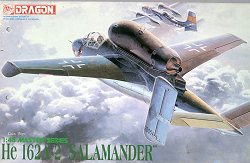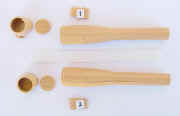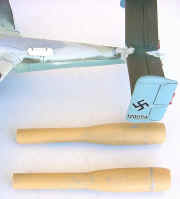The Heinkel He 162, known as the "Volksjager" ( people's fighter), " Spatz" ( Sparrow), or " Salamander" ( incorrectly, because to the whole program was given this code name, and it has been applied to the aircraft itself) was a jet fighter born of desperation. Although the design was put together in weeks, the results was an exceptional aircraft; gifted with agility, economy and speed.
|
The fuselage of the He 162 was a light metal monocoque and the single piece wing was mainly constructed of wood and secure to the aircraft with only four bolts. The typical turned-down wingtips of the aircraft were removed and replaced by standard tips. Power came from a single BMW 003 A-1 " Sturm" turbojet which was set atop the fuselage, aft the cockpit.
In early 1945, due to the backlog of BMW engines, consideration was also given to outfitting the He 162 with Argus pulsejets, the engine for the V-1.
|

|
Thus the He 162 A-10 and A-11 came into being. The A-10 had two Argus As 014 thruster rockets, while the A-11 had the more powerful As 044. An A-10 (factory number M-42), flew at the end of March 1945 in Bad Gandersheim.
The problems with the pulsejets as means of propulsion was several; the main issue was the heavy vibration caused by the engine itself. Due to this, further development of the He 162 a-10 was abandoned.
The conversion
In keeping with my practice of building strange and unusual models, I was very pleased to come across some reference material of one of the rarest World War Two fighters, the He 162 A-10 ( there was only one built and flew). I was going to build this aircraft conversion in 1/72 scale, but I got my hands on an 1/48 scale Dragon He 162 A-2 Salamander ( kit #5508 ) at a model swap meet about a year ago.
|
This conversion consist simply in replacement the BMW engine by two resin Argus As 014 pulsejets, which are available from ANTARES, a little manufacturer of the commonly known "garage kits", Ref # ANT-01.
This new conversion set comprises eight resin parts and a little piece of laminated sheet styrene, and is specially designed for the He 162 A-10.
|

|
The quality of these parts are good, and the resin is easy to work. Overall the main components are well formed but do need some cleaning up from little flash. This set retails for just U$S 10 and this represent excellent value for money when you consider what you get in the pack.
Included in the bag, there is a double sided four steps instruction sheet, with good diagrams that helps to modify the Dragon kit and thus, to materialize this interesting project.
|
I began by shaving-off the engine located atop of fuselage with a hot sharp blade. Then, I removed with a 400 grit wet/dry sandpaper the lower engine structure to flattened the upper surface. The hole that results of these was filled with Tamiya putty and sanded with a 600 grit wet sandpaper to smooth. In his manual, ANTARES recommends to add weight, in two sites, to hold the model down: on the nose cone and inside the fuselage behind the cockpit, due to the weight of the resin parts.
When the fuselage was ready, I was attached to it the resin engines by two supports struts. The frontal piece is cast in resin, and the rear was cut of the adequate size from the laminated styrene sheet from the set. When I assembled these parts, I kept in mind that the pulsejets was in " V " angle, immediately aft of the leading edge of the wings ( the instruction sheet provides three views in the fourth step ).
|

|

|
Finishing
Finally, I discarded the turned-down wingtip extensions from the original kit, and replaced these with two pieces of sheet styrene, conveniently filed and sanded.
Painting was easy: RLM 76 ligth grey on lower surfaces and RLM 81 dark green on the upper surfaces of the aircraft. I found replacement decals in my spares box, and use black transfers for factory numbers.
This conversion is really recommendable for the beginner that are interested, like me, in strange German World War Two models; and the experienced modelers can produce a neat replica of this "rara avis" of Luftwaffe.
I want to thank to Antares for providing me with the sample for this note
Sources
Heinkel He 162 " Volksjager ", by Heinz J. Nowarra, Schiffer Military History, 1993.
|